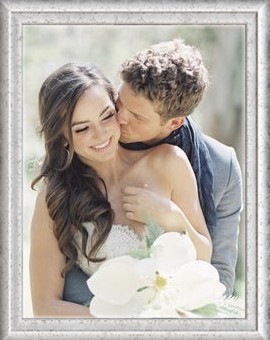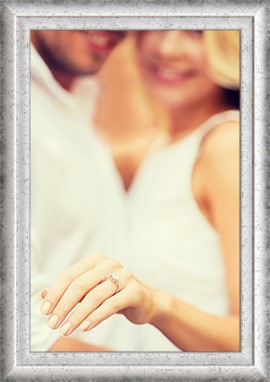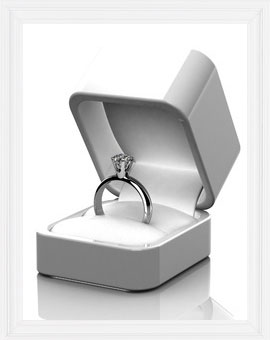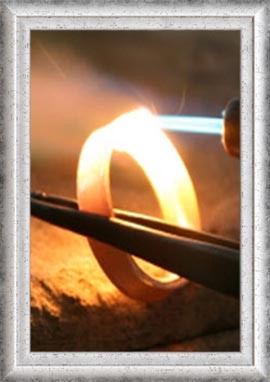History Of Wedding Rings
History Of Wedding Ring
Today, the wedding ring symbolizes a promise of never-ending love, devotion, and loyalty. In short, it is the physical representation of the wedding vows. The history of the wedding ring, however, is not quite as romantic. Throughout history, the wedding ring has symbolized various parts of the traditional wedding vows, but rarely all at the same time.
The wedding ring, that most famous and instantly recognizable symbol of the joining of a man and a woman as husband and wife in the institution of marriage, has a long, wide spread and mysterious history. Its beginnings lie in the deserts of North Africa, where the ancient Egyptian civilization sprang up along the fertile flood plains of the river Nile. This river was bringer of all fortune and life to the Pharaoh’s people and from plants growing on its’ banks were the first wedding rings fashioned. Sedges, rushes and reeds, growing alongside the well-known papyrus were twisted and braided into rings for fingers and larger bracelets for wrists.
The wedding band's shape represents an unbroken promise of love and commitment. The circle has no beginning and no end; therefore, the marriage has no end. It is believed that many past cultures shared the same beliefs about the circles.
There is, however, another theory behind the ring's shape. Many religions consider marriage as "half of the religion." Some historians say that the wedding ring represents two halves coming together to form a united whole. By completing the circle, primitive man also completed his religion.
The ring is of course a circle and this was the symbol of eternity for the Egyptians as well as many other ancient cultures. It had no beginning and no end, like time. It returned to itself, like life; and the shape was worshipped in the form of the Sun and the Moon. The hole in the center of the ring is not just space either; it is important in its own right as the symbol of the gateway, or door; leading to things and events both known and unknown.
In ancient times, the Egyptians and the Romans shared the belief that a vein from the fourth finger lead directly to the heart. As such, it seemed a logical place for the placement of the wedding band. The practice was passed down and the fourth finger is now universally known as the ring finger. Science has since disproved that theory, but it is still romantic to think that our wedding rings are on a direct path to our hearts.
They wore it like we do today, on the third finger of the left hand, because of a belief that the vein of that finger directly traveled from the heart. This legend was later taken up by the Greeks, when they conquered Egypt under the generalship of Alexander the Great in 332 B.C. and from them passed onto the Romans, who called this the ‘vena amoris’, which is Latin for ‘the vein of love’.
Archaeologists have found references to wedding rings among the Ancient Egyptians' hieroglyphics. The Egyptians shaped twigs, hemp, or plant stems into circles and placed them on their brides' ring fingers. The plant rings quickly decayed or were broken and had to be frequenlty replaced. The circles represented undying love, much as they do today. Apparently they did not represent fidelity, though, as many of the Ancient Egyptians were polygamous.
* To Obey
Although the Ancient Romans placed a ring on the fourth finger of their wives hands, the practice had little to do with love and devotion. Rather, wives were a possession to the Romans and the ring was a sign of ownership. Ancient Roman women had no voice in this decision; there was no proposal. Once the women were captured and "ringed," they were married.
* To be Faithful
Men of the Far and Middle East had a unique way of ensuring that their brides remained faithful. They created "puzzle rings," rings that were collapsible. If a wife tried to remove her ring, the ring would fall apart. The ring could be put back together, but only if one knew the correct arrangement. If the husband had to travel for business or during wartime, the puzzle rings were used to keep the wife true.
* I Give this Thimble
In the early days of American colonization, the Puritan way of thinking said that any form of adornment was wasteful and immoral. Of course, this meant there were no rings. Instead, men gave their brides thimbles as tokens of undying love and devotion. The resourceful brides often removed part of the thimble and created makeshift rings.
* For Richer and Poorer
As time went by and the rules became looser, the move towards modern rings began. Materials for the rings have varied through the years, depending on personal wealth and the nation's economy. Wedding rings of the past have been made of leather, stone, aluminum, and metal. Today, wedding rings are almost always made of gold, silver, or platinum. Some people choose alternative rings, such as titanium or tatoos.
* Husband's Wedding Ring
Wedding bands for men are a fairly recent innovation. Throughout history, men have been dominant and either owned wives or lead harems. There was no need for men to be burdened by symbols of marriage and commitment. Even after modern thinking outlawed all forms of slavery and polygamy, the fingers of men were still unadorned. All of that changed during World War II. During the war it became fashionable for men to wear bands to remind them of the loving wives waiting back home. Use of wedding rings by men increased again during the Korean War. Today, most men wear wedding bands, regardless of military status.





